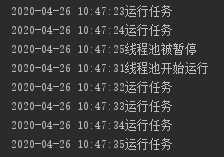示例代码
import java.text.SimpleDateFormat;
import java.util.Date;
import java.util.concurrent.*;
import java.util.concurrent.locks.Condition;
import java.util.concurrent.locks.ReentrantLock;
/**
* 自定义一个具有暂停功能的线程池
*/
public class MyThreadPoolExecutor extends ThreadPoolExecutor {
//暂停标志
private static boolean pause = false;
//定义一个锁,保证多线程情况下的线程安全
private static final ReentrantLock lock = new ReentrantLock();
//使用Condition
private static Condition condition = lock.newCondition();
public MyThreadPoolExecutor(int corePoolSize, int maximumPoolSize, long keepAliveTime, TimeUnit unit, BlockingQueue<Runnable> workQueue) {
super(corePoolSize, maximumPoolSize, keepAliveTime, unit, workQueue);
}
public MyThreadPoolExecutor(int corePoolSize, int maximumPoolSize, long keepAliveTime, TimeUnit unit, BlockingQueue<Runnable> workQueue, ThreadFactory threadFactory) {
super(corePoolSize, maximumPoolSize, keepAliveTime, unit, workQueue, threadFactory);
}
public MyThreadPoolExecutor(int corePoolSize, int maximumPoolSize, long keepAliveTime, TimeUnit unit, BlockingQueue<Runnable> workQueue, RejectedExecutionHandler handler) {
super(corePoolSize, maximumPoolSize, keepAliveTime, unit, workQueue, handler);
}
public MyThreadPoolExecutor(int corePoolSize, int maximumPoolSize, long keepAliveTime, TimeUnit unit, BlockingQueue<Runnable> workQueue, ThreadFactory threadFactory, RejectedExecutionHandler handler) {
super(corePoolSize, maximumPoolSize, keepAliveTime, unit, workQueue, threadFactory, handler);
}
@Override
protected void beforeExecute(Thread t, Runnable r) {
super.beforeExecute(t, r);
lock.lock();
try {
while (pause) {
condition.await();
}
} catch (InterruptedException e) {
e.printStackTrace();
} finally {
lock.unlock();
}
}
/**
* 暂停方法
*/
public void pause() {
lock.lock();
try {
pause = true;
} finally {
lock.unlock();
}
}
public void start() {
lock.lock();
try {
pause = false;
condition.signalAll();
} finally {
lock.unlock();
}
}
}
试下这个具有暂停功能的线程池:
import java.text.SimpleDateFormat;
import java.util.Date;
import java.util.concurrent.LinkedBlockingQueue;
import java.util.concurrent.TimeUnit;
public class MyThreadPoolExecutorTest {
static MyThreadPoolExecutor myThreadPoolExecutor = new MyThreadPoolExecutor(1, 1, 0, TimeUnit.SECONDS, new LinkedBlockingQueue<Runnable>());
final static SimpleDateFormat sdf = new SimpleDateFormat("yyyy-MM-dd HH:mm:ss");
static class Task implements Runnable {
@Override
public void run() {
try {
TimeUnit.SECONDS.sleep(1);
} catch (InterruptedException e) {
e.printStackTrace();
}
System.out.println(sdf.format(new Date()) + "运行任务");
}
}
public static void main(String[] args) throws Exception {
for (int i = 0; i < 6; i++) {
myThreadPoolExecutor.execute(new Task());
}
TimeUnit.SECONDS.sleep(2);
myThreadPoolExecutor.pause();
//睡眠一秒钟,方便看出结果
TimeUnit.SECONDS.sleep(1);
System.out.println(sdf.format(new Date()) + "线程池被暂停");
TimeUnit.SECONDS.sleep(6);
myThreadPoolExecutor.start();
System.out.println(sdf.format(new Date()) + "线程池开始运行");
myThreadPoolExecutor.shutdown();
}
}
运行结果:

可以看到在10:47:25时,线程池被暂停,直到10:47:31线程池开始运行前,中间没有任何线程任务在执行,实现了一个具有暂停功能的线程池。
总结
这里只是重写了ThreadPoolExecutor类的一个beforeExecute()方法就实现了这个暂停的功能,其实其中还有很多方法都能重写,比如通过重写beforeExecute()和afterExecute()方法就能够实现在线程池提交任务前后记录日志的功能,方法可以被重写,就代表了无限的可能性。

